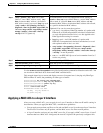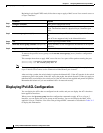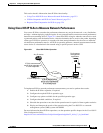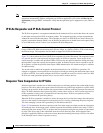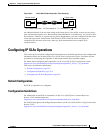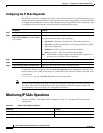
32-2
Catalyst 2960 and 2960-S Switch Software Configuration Guide
OL-8603-09
Chapter 32 Configuring Cisco IOS IP SLAs Operations
Understanding Cisco IOS IP SLAs
Understanding Cisco IOS IP SLAs
Cisco IOS IP SLAs sends data across the network to measure performance between multiple network
locations or across multiple network paths. It simulates network data and IP services and collects
network performance information in real time. Cisco IOS IP SLAs generates and analyzes traffic either
between Cisco IOS devices or from a Cisco IOS device to a remote IP device such as a network
application server. Measurements provided by the various Cisco IOS IP SLAs operations can be used for
troubleshooting, for problem analysis, and for designing network topologies.
Depending on the specific Cisco IOS IP SLAs operation, various network performance statistics are
monitored within the Cisco device and stored in both command-line interface (CLI) and Simple Network
Management Protocol (SNMP) MIBs. IP SLAs packets have configurable IP and application layer
options such as source and destination IP address, User Datagram Protocol (UDP)/TCP port numbers, a
type of service (ToS) byte (including Differentiated Services Code Point [DSCP] and IP Prefix bits),
Virtual Private Network (VPN) routing/forwarding instance (VRF), and URL web address.
Because Cisco IP SLAs is Layer 2 transport independent, you can configure end-to-end operations over
disparate networks to best reflect the metrics that an end user is likely to experience. IP SLAs collects a
unique subset of these performance metrics:
• Delay (both round-trip and one-way)
• Jitter (directional)
• Packet loss (directional)
• Packet sequencing (packet ordering)
• Path (per hop)
• Connectivity (directional)
• Server or website download time
Because Cisco IOS IP SLAs is SNMP-accessible, it can also be used by performance-monitoring
applications like CiscoWorks Internetwork Performance Monitor (IPM) and other third-party Cisco
partner performance management products. You can find more details about network management
products that use Cisco IOS IP SLAs:
http://www.cisco.com/go/ipsla
Using IP SLAs can provide these benefits:
• Service-level agreement monitoring, measurement, and verification.
• Network performance monitoring
–
Measures the jitter, latency, or packet loss in the network.
–
Provides continuous, reliable, and predictable measurements.
• IP service network health assessment to verify that the existing QoS is sufficient for new IP services.
• Edge-to-edge network availability monitoring for proactive verification and connectivity testing of
network resources (for example, shows the network availability of an NFS server used to store
business critical data from a remote site).
• Troubleshooting of network operation by providing consistent, reliable measurement that
immediately identifies problems and saves troubleshooting time.
• Multiprotocol Label Switching (MPLS) performance monitoring and network verification (if the
switch supports MPLS)






